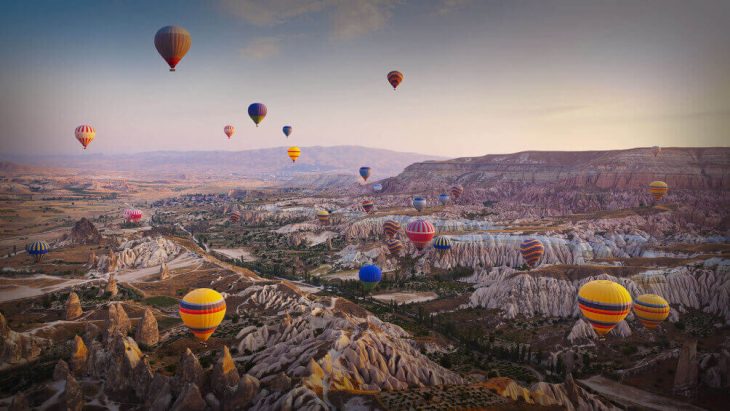There are lot of reasons to return to Turkey this summer. Exit the traditional Grand Bazaar and the crowded beaches of Bodrum. The country, again accessible to the French since June 17, is full of unknown routes. Selection of favorite experiences.
Return to Turkey : Board an iconic train
Ernest Hemingway, Leo Tolstoy, Agatha Christie or Graham Greene have one thing in common: they all traveled on the Orient Express and, from these journeys, masterpieces of literature were born. This train, which linked Paris to Istanbul, has inspired generations of globetrotters. But Turkey is not left out. Another railway line was built in 1962 inside the country: the Doğu Ekspresi, the “Eastern Express”.
This train now crosses the country from West to East, from its capital Ankara to the city of Kars, on the Armenian border. It takes 32 hours to travel the 1,310 kilometers between the two stations, with five stops where it is possible to stop off. With its first-class cabins with outdated decoration (but clean and very comfortable) and its average speed of 70 km/h, it has everything of an anachronism. This is precisely what travelers come to find there: a feeling of deceleration where one has the sole mission of contemplating the landscapes passing before our eyes.
Return to Turkey : Explore the ruins of the first temple in history
Thousands of years before the Egyptian pyramids or the Neolithic Stonehenge, it already reigned supreme in southeastern Anatolia, the border region between present-day Turkey and Syria. The temple of Göbekli Tepe, whose name means “navel hill” in Turkish, was built on the highest point of the Germuş mountain range (785 m). The first excavations, conducted in 1995, revealed a series of stone circles about 300 meters in diameter and monuments decorated with engravings (wild animals, humans, etc.). The megalithic structures are said to have been erected by groups of Neolithic hunter-gatherers, then used in funerary rituals, before being swallowed up and hidden from the rest of humanity.
Thus considered the oldest temple in the world, the archaeological site provides insight into the worldview and beliefs of people living in Upper Mesopotamia around 11,500 years ago. Classified in July 2018 as a UNESCO World Heritage Site, it has been in the spotlight more recently thanks to its appearance in the Netflix original series “Atiye”.
Return to Turkey : Witness the nesting of sea turtles
In Muğla Province, in the southwest of the country, a narrow strip of golden sand forms a natural barrier between the Dalyan River and the Mediterranean Sea. This paradise beach, named İztuzu, is one of the few breeding and habitat sites of the loggerhead turtle (Caretta caretta) in the world. The marine reptile, about 90 cm long, is now on the IUCN Red List of Threatened Animals.
To ensure their protection, volunteers from the Sea Turtle Research and Rehabilitation Center monitor the nests all year round. The 4.5 km of sand have also been classified as a “natural site” and protected, so access to visitors is only possible during the day, because it is at night that the eggs hatch and the baby turtles throw themselves into the sea. water for the first time. If you want to attend this extraordinary spectacle and have a myriad of information on the life cycle of the species, it is however possible to send a request to the Center at the address: dekamerturkey@gmail.com (in English only).
Savor the “new” Anatolian cuisine
Since the 15th century, Turkey has been a crossroads between Europe, Asia and the Orient. This geographical location, combined with migrations linked to the conquests of the Ottoman Empire (Balkans, Syria, Iraq, Egypt, Cyprus…), shaped the identity of its gastronomy. If the French often reduce it to its specialty of kebab, it is nevertheless imbued with flavors that are sometimes Asian, Oriental or Mediterranean.
It is with the idea of promoting this very rich heritage that the Turkish-Scandinavian chef Mehmet Gürs, television personality, launched the concept of “New Anatolian Kitchen”. This approach is both respectful of Turkish tradition and local products while being anchored in a very contemporary cuisine. In his Mikla restaurant, on the 18th floor of the Marmara Pera hotel, Nordic and Turkish flavors come together in surprising and perfectly balanced blends, rewarded in 2018 with the title of “World’s 50 Best Restaurants”.
Enter an avant-garde mosque
Emblem of the secular republic of Mustafa Kemal Atatürk, the transformation of Hagia Sophia into a mosque, decided by the Islamic-conservative president Recep Tayyip Erdoğan, hit the headlines last year. But this must-see tourist attraction, classified as a UNESCO World Heritage Site, is far from being the only religious building that deserves attention. On the Asian side of Istanbul, in the district of Üsküdar, the Şakirin mosque stands out with its cupola and its architectural forms… all in curves.
Sponsored by a rich Turkish-Saudi family, it is the first in the world to have been decorated by a woman: Zeynep Fadıllıoğlu, previously known for her creations of posh restaurants in London or Istanbul. Inside the mosque designed by a mostly female team of architects, golden verses from the Koran ripple along the glass walls, while the turquoise-colored mihrab (niche that indicates the direction of Mecca) features the shape of a seashell. In this place, more than anywhere else, the meeting between tradition and the avant-garde is resolutely successful.


 19 April 2022
19 April 2022